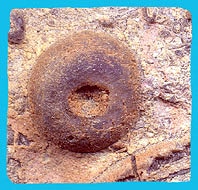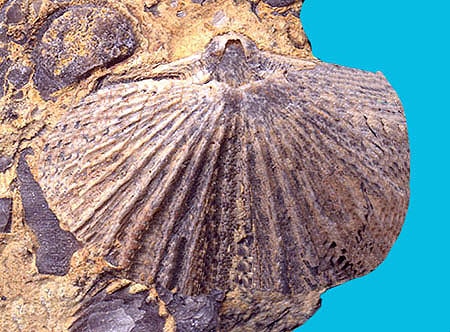 This is why I come to Beatty, Nevada and stay in a motel that allows dogs, has tile falling off the wall, and is, well, not exactly 4 star quality. The only restaurant in the entire town is a Denny's. Yes, that's it and it's miles and miles and even more miles to another town. Outside, you can hear the wild donkeys bray and behind the motel is a creek when the donkeys come to drink and the wildlife plays. The birds are abundant and their calls fill the air. In addition to animals, my own included... Beatty is also the staging area for a truly remarkable fossil locality--the great Middle Ordovician mudmound/bioherm on the flanks of the mountains in the vicinity of town--a geologically and paleontologically fascinating unstratified pod-shaped accumulation of calcium carbonate, limestone, some 1,000 feet in length around which (and within the core of which) profuse invertebrate animal remains can be found. From a distance, the mountains within which the fossil locality lies appear to be an inhospitable moonscape of a place--a virtually barren upthrusting of desert rocks that overlook the Nevada Atomic Test Site to the immediate east; such a juxtaposition of locales--a direct reminder of our nuclear age in such proximity to a world-class Ordovician-Period fossil site--only serves to provide a greater aura of intrigue and mystery to a locality that contains such a wealth of prehistory to study. While apparently sparse in plant life, the great Beatty mudmound more than atones for this botanic deficiency with its fantastic abundance of Middle Ordovician fossils in a geologic rock formation geologists call the Antelope Valley Limestone. Here can be found a wealth of excellently preserved invertebrate animal remains some 480 million years old, including echinoderms, sponges, bryozoans, ostracodes (tiny bivalve crustaceans related to barnacles), pelecypods, gastropods, trilobites, conodonts, cephalopods and brachiopods. All of the specimens, save the conodont elements, have been thoroughly silicified--that is, replaced by the mineral silicon dioxide--so the fossils can be dissolved out of their limestone matrix without damage using a dilute solution of acid. Acetic acid, by the way, must be used to find the conodonts. The Beatty mudmound/bioherm is such a wonderfully fossiliferous and paleontologically impressive place that, recently, a Public Interest group nominated it for special protection by the Bureau of Land Management. No final decision on its eventual status has yet been made, but BLM officials will soon conduct public hearings to determine whether the Beatty mudmound fossil beds should be placed into a special designation called an Area Of Critical Environmental Concern (ACEC, for short). If that designation comes to pass, the Beatty mudmound will most certainly become off-limits to all amateur fossil hunters; only those with degrees from an accredited university or personnel representing a museum will then be allowed to collect fossils there. A noted fossil-bearing Area Of Critical Environmental Concern already administered by the BLM is the Upper Pleistocene Manix Lake Beds, Mojave Desert, California, where important Ice Age remains of fish, mammals, birds and mollusks occur along the dry channel of the Mojave River near Afton Canyon; in both areas, presently overseen by the Bureau of Land Management, fossil collecting is illegal without a special use permit, a permit given only to trained scientists with a degree who seek to undertake fully verifiable research investigations. Not only are Ordovician fossils abundant in the vicinity of Beatty, but significant mineral exploration and exploitation also continues. For example, a few miles southeast of Beatty lies the Daisy Fluorspar Mine, a private claim once owned by J. Irving Crowell, Jr. and son. The Daisy Mine was discovered in 1918 and produced continuously from 1927 through the early 1960s. Total production up to that date was approximately 100,000 tons. Considerably more has probably been mined sine then, one ought to presume, as the Daisy Flourspar Mine is likely one of the single greatest sources of fluorspar in the history of Nevada. The ore bodies occur as hydrothermal replacements in dolomites of the Upper Cambrian (515 million years old) Nopah Formation; cinnabar--mercury sulfide--has also been reported from the Daisy Mine, primarily as thin red stringers between fluorite and bands of calcite. To read more click here. I cannot wait to get started. Comments are closed.
|
Sign up today for freebies and fun. Grab your chance at signed copies of my paperbacks and free e-books.
For Kobo coupons click here or copy and paste the link into your browser.
http://www.therawfeed.com/stores/kobobooks-com |
Proudly powered by Weebly





 RSS Feed
RSS Feed

